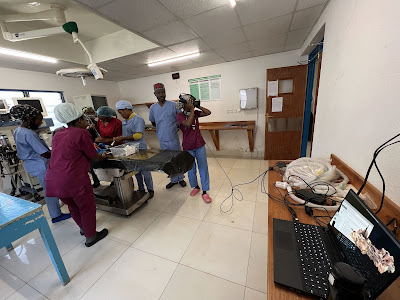By Alyssa
As one of the most developed hospitals in a small country, we get our share of VIPs, and there is always a tension at to how much time and energy to spend on them versus the rest of the patients. My sense is that this is a challenge in lots of places but especially for mission hospitals in developing countries where the goals of medical excellence, compassionate care for the poor, quality education for trainees, and financial sustainability can sometimes seem impossible to pursue simultaneously.
Kibuye Hope Hospital's vision is to:
"Develop a university hospital of excellence where the love of God is manifested to his creatures."
Our mission is:
"To glorify God through quality physical and spiritual care accessible to all and through the training of healthcare professionals and disciples of Jesus Christ."
I'd like to share about a few patients I saw yesterday who aren't particularly prominent by the world's standards but who I hope experienced the love of God at our hospital. I would love for them to walk away from this place after receiving quality healthcare by compassionate healthcare workers with the sense that they are seen and known as Very Important People in the eyes of our Heavenly Father.
1) Mama D (pictured above with one of our nurses, picture taken with permission). This mama is so faithful to care for her little girl through so many heartbreaking challenges over the last few months. She has been in and out of the hospital multiple times and has often stayed for weeks at a time due to complications from probable tetanus. Her mother faithfully keeps every appointment, feeds her and give her meds through an NG tube (and amazingly, the little girl is not losing weight or malnourished), and is attuned to every new symptom that means she needs to bring her back to the hospital. We had the chance to encourage Mama D yesterday that she is doing such a great job in caring for her daughter, and she just beamed. She and her husband display great faith in praying for their daughter and not despairing despite the myriad of challenges their little one faces.
2) "Isaac" is a 13-year-old boy who came to his follow-up appointment in peds clinic yesterday for cyanotic congenital heart disease. When they checked his oxygen level in triage, they were so concerned that they sent him to the emergency room instead of clinic. But then they came to find me and I explained that his oxygen levels are always that low. Sure enough, Isaac entered my clinic walking and talking normally a few minutes later despite his oxygen saturation of 65%. Isaac is one of the oldest patients I have seen here with cyanotic congenital heart disease (probably Tetralogy of Fallot for the medical folks). He's actually still attending school and can walk short distances around the hill where he lives. It's difficult to decide what medicines to treat him with because the medical literature generally assumes patients with this condition had surgery to repair it as infants. He's currently taking three heart meds and seems to be relatively stable, so we refilled the prescriptions and gave him a follow-up appointment in three months.
3) "Emmy" is the 7th child in her family and there were complications with her birth. She was resuscitated for a prolonged period of time and that resulted in neurologic complications. Now she is 2-years-old but doesn't walk or talk or even sit up on her own. This is unfortunately a very common story here. Her mom brought her to peds clinic to see if we could help with her development. Emmy smiles and seems aware of her environment but has very little muscle tone. We gave her a referral to a center nearby that provides physical therapy, but there's not a lot else we can do for her. We did explain that she is a beloved child of God, and her mom readily agreed!
4) Mama A brought her son to the hospital because of a huge tumor in his eye. She heard that there was a center here that could treat this condition, so she traveled from quite far away with her son and his little brother. The boy has now been hospitalized in the malnutrition service for over a month. Unfortunately the cancer (retinoblastoma) was very advanced and already metastatic when they arrived. We have given chemotherapy with the goal of palliative care (to shrink the size of the tumor and decrease his pain), but the boy is still not well enough to eat or drink or talk. He will likely go home tomorrow to continue palliative care. I hope the mother leaves with the sense that she did everything she could for her child and that there is no shame or curse associated with the condition he has. I will miss greeting her and the little brother each day.
5) "Arthur" is a 4-year-old boy with epilepsy who came to clinic for follow up. Thankfully his seizures are well controlled on treatment. He has only had one seizure in the last year. He has some developmental delay as well, but he is making good progress. His mother is pleased with how he's doing. We refilled the medication and gave him a follow-up appointment for early next year.
We want to keep growing and improving in the level of care we can provide for all the patients at Kibuye Hope Hospital. And yet as some of these stories show, we can't always provide physical healing for them given the resources available in our setting. But no matter what medicines or treatments are available, we desire that the love of God be manifested to all the patients along with their family members. Our specific pediatric vision includes the phrase "welcoming children, families, staff, and students as Jesus welcomes us." Please pray that this vision will be realized more and more in this beautiful corner of the world.










